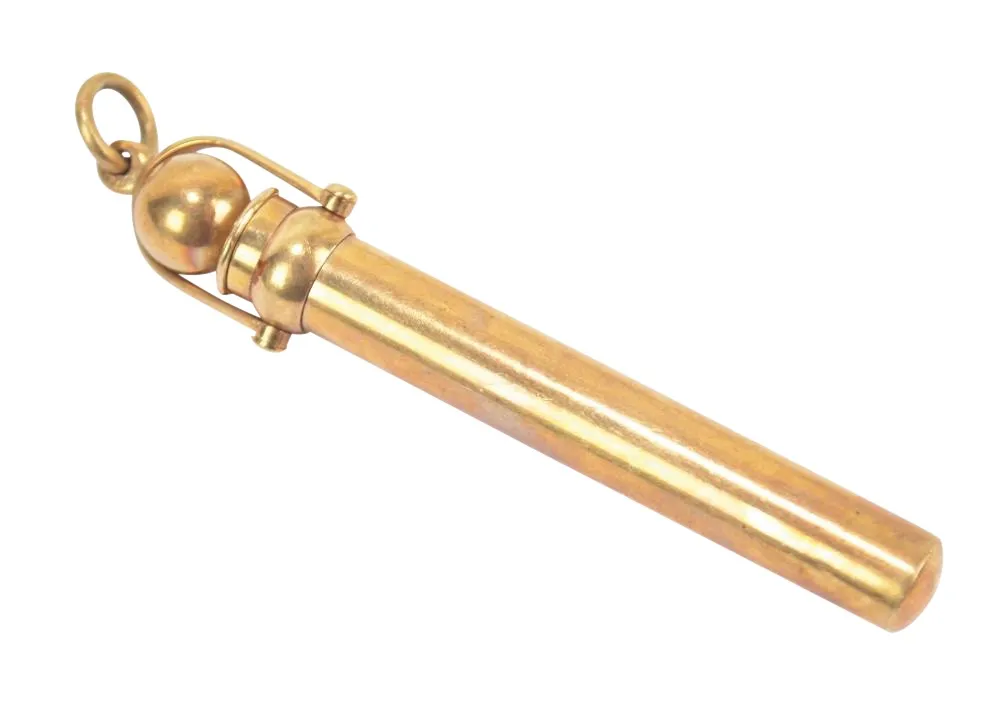The name Sampson Mordan is so synonymous with the propelling pencil that it would be natural to imagine he was the inventor of what would become the must-have Victorian objet de vertu, yet there is evidence that lead propelling pencils were in existence some time before Mordan ever dabbled with the innovation.
Examples of early sliding pencils have been found in various shipwrecks from the 18th century, including HMS Pandora, which sank on the Great Barrier Reef in 1791. However, in 1822, it was Mordan who first patented the ‘mechanical’ pencil, alongside inventor Isaac Hawkins, his colleague at the time.
And it was Mordan’s shrewd business sense and deep-rooted dedication to his philosophy – ‘make something of quality and people will buy it’ – that drove him to create hundreds of superb examples of these pencils. Such was the workmanship, the pencils became one of the most fashionable accessories of the 19th century, cementing Mordan’s legacy.

Mordan’s ‘Everpoint’ pencil, which had an internal mechanism to propel the graphite shaft forward during use, was a huge improvement on existing pencils and the invention was quickly adopted by the middle and upper classes of the time. Wrought in precious metals, most commonly silver or gold, the pencils made lavish gifts and were cherished by their owners.
After a while, practicality gave way to novelty, and Mordan’s company began creating pencils in every form imaginable, from animals to Egyptian artefacts, sporting accessories and even human figures. As one might expect, it is these whimsical forms that are among the most collectable today.
‘The most expensive Mordan pencils are the novelty or figural examples produced in the latter part of the 19th century,’ says David Buck of Steppes Hill Farm Antiques. ‘Mordan described them as “fancy pencils”. They’re usually of good quality cast construction and the prices for rare individual examples have exceeded £3,000.’
You might also like how to collect antique pens
Depending on their rarity and quality, novelty pencils can, however, be found for less. A good example of their wide-ranging value is the Woolley & Wallis auction of the ‘KB Collection of Pencils’ in January 2019. The collection, amassed by Kenneth Bull of John Bull Antiques Ltd, was made up of 464 items and thought to be the most comprehensive of its kind.
Many of the pencils in the collection were made by Mordan’s company, and novelty pencils at the sale attracted winning bids from the low hundreds to £2,200 for a very rare pencil shaped like a soldier in a sentry box.

More utilitarian and conventionally shaped Mordan pencils can generally be picked up for less. ‘Standard Mordan silver, sliding, propelling pencils from the Victorian era can still be had for £50 to £100, although not usually hallmarked examples,’ suggests David.
You might also like how to clean antique silver
While not all Mordan pencils are hallmarked, most do carry his name or initials, and if you’re interested in starting a collection, it’s worth researching the various incarnations of marks as they can help to date and identify pieces.
‘If the pencil is made of gold or silver there will usually be an assay mark with the Sampson Mordan maker’s mark, the assay office (London, Chester or Sheffield for Mordan pieces) and the date mark,’ says Fiona Young, valuer at Adam Partridge Auctioneers & Valuers.
‘The maker’s mark will be different depending on the assay office and the year. From 1823 he was using SM as his maker’s mark. Other early examples may be assayed SM.GR, for 1825 to 1836 when Mordan was in partnership with Gabriel Riddle.
A company was formed later on, so the maker’s mark became S.Mordan & Co, used after his death in 1843 when his sons continued the business.’
Fiona also points out that some silver pencils are marked ‘Sterling Silver’ rather than with an assay mark, but these and silver-plated examples will usually still bear the Mordan name. Sometimes the pencils are marked ‘Everpoint’, while ‘Centennial’ pencils were produced from 1922 to 1924 to mark the centenary of the first Mordan patent.

Such marks offer useful clues for identifying Mordan pencils, but what else should prospective collectors look for? ‘In Mordan pencils, good workmanship and high quality is assured,’ says Fiona. ‘But as with most collectable antique items, condition is very important. Only perfect examples will command high prices.’
Consequently, it is advisable to seek out pieces that are in a good state of repair, which includes the assay marks being clearly visible. There is also much greater value in pencils that can still be used today (leads can be bought to fit Mordan pencils), so avoid examples with missing parts or dents.
‘A potential bar to the use of a Victorian pencil is if the mechanism is damaged, which is one of the reasons why it is better to see and try the pencil in person rather than relying on a website description,’ advises Fiona.
In addition, rare or novelty pencils tend to be the most desirable, while style of decoration can also affect price, as can material – gold pencils are predictably worth more than their silver-plated counterparts.
It’s easy to see why collectors are so drawn to these items. Not only are they often still practical – allowing us to hold and use a pencil that has its own long story to tell – but they are also beautiful, from elegant and functional early examples to the elaborate and imaginative ‘fancy’ designs of the later 19th century and beyond.
So whether you’d like to find one perfect piece or assemble a diverse collection, Mordan pencils represent an utterly appealing field for antiques lovers.
